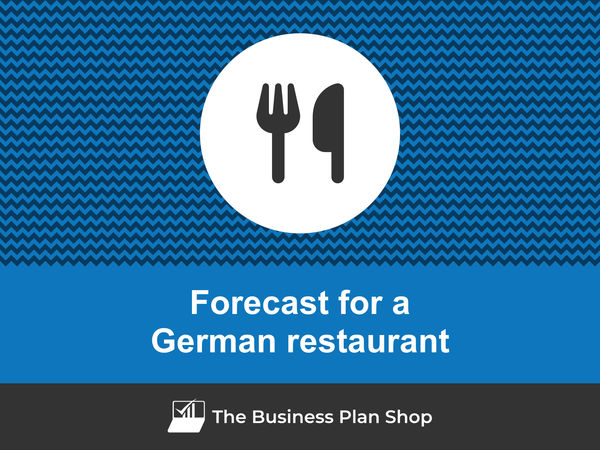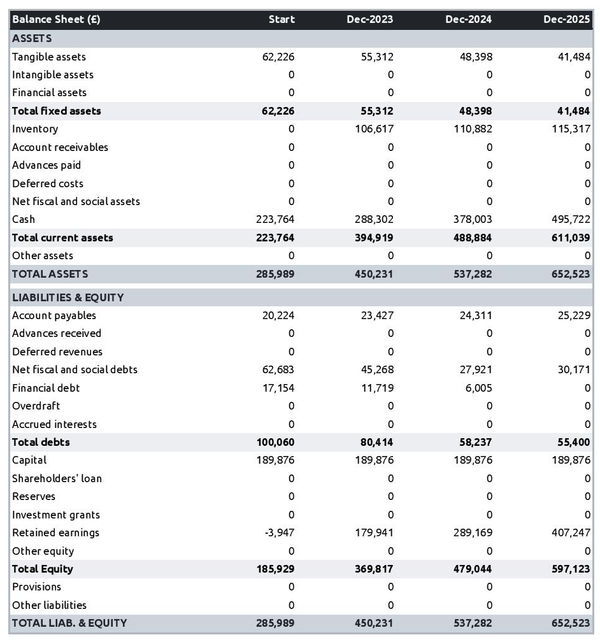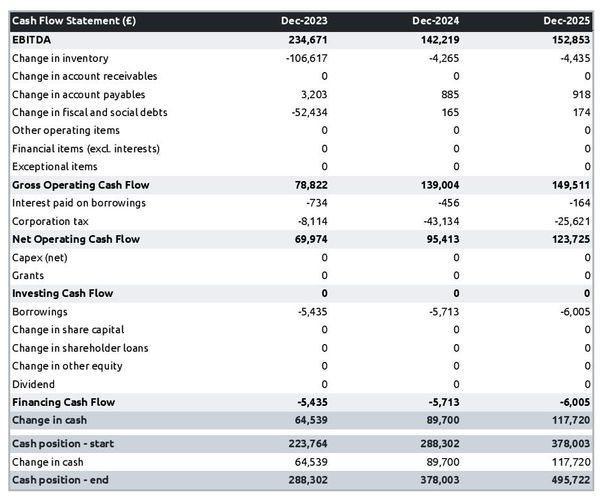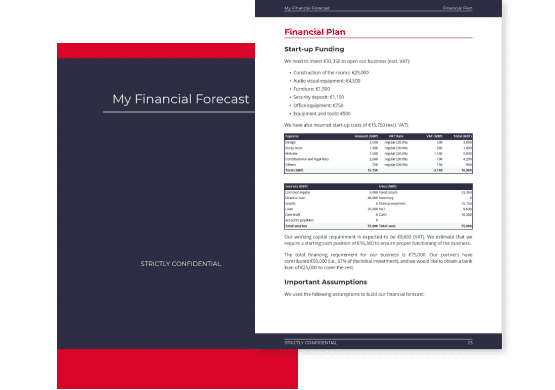How to create a financial forecast for a German restaurant?

Creating a financial forecast for your German restaurant, and ensuring it stays up to date, is the only way to maintain visibility on future cash flows.
This might sound complex, but with the right guidance and tools, creating an accurate financial forecast for your German restaurant is not that hard.
In this guide, we'll cover everything from the main goal of a financial projection, the data you need as input, to the tables that compose it, and the tools that can help you build a forecast efficiently.
Without further ado, let us begin!
Why create and maintain a financial forecast for a German restaurant?
Creating and maintaining an up-to-date financial forecast is the only way to steer the development of your German restaurant and ensure that it can be financially viable in the years to come.
A financial plan for a German restaurant enables you to look at your business in detail - from income to operating costs and investments - to evaluate its expected profitability and future cash flows.
This gives you the visibility needed to plan future investments and expansion with confidence.
And, when your trading environment gets tougher, having an up to date German restaurant forecast enables you to detect potential upcoming financing shortfalls in advance, enabling you to make adjustments or secure financing before you run out of cash.
It’s also important to remember that your German restaurant's financial forecast will be essential when looking for financing. You can be 100% certain that banks and investors will ask to see your numbers, so make sure they’re set out accurately and attractively.
Need a solid financial forecast?
The Business Plan Shop does the maths for you. Simply enter your revenues, costs and investments. Click save and our online tool builds a three-way forecast for you instantly.

What information is used as input to build a German restaurant financial forecast?
A German restaurant's financial forecast needs to be built on the right foundation: your assumptions.
The data required to create your assumptions will depend on whether you are a new or existing German restaurant.
If you are creating (or updating) the forecast of an existing German restaurant, then your main inputs will be historical accounting data and operating metrics, and your team’s view on what to expect for the next three to five years.
If you are building financial projections for a new German restaurant startup, you will need to rely on market research to form your go-to-market strategy and derive your sales forecast.
For a new venture, you will also need an itemised list of resources needed for the German restaurant to operate, along with a list of equipment required to launch the venture (more on that below).
Now that you understand what is needed, let’s have a look at what elements will make up your German restaurant's financial forecast.
The sales forecast for a German restaurant
From experience, it is usually best to start creating your German restaurant financial forecast by your sales forecast.
To create an accurate sales forecast for your German restaurant, you will have to rely on the data collected in your market research, or if you're running an existing German restaurant, the historical data of the business, to estimate two key variables:
- The average price
- The number of monthly transactions
To get there, you will need to consider the following factors:
- The popularity of German cuisine in your local area: If there is a high demand for German food in your community, you may be able to charge higher prices and attract more customers to your restaurant.
- The availability of German ingredients: Your average price may be affected by the cost and availability of traditional German ingredients, such as sausages, sauerkraut, and beer. If these ingredients become more expensive or difficult to source, you may need to adjust your prices to maintain profitability.
- The competition from other German restaurants: If there are several German restaurants in your area, you may need to keep your prices competitive to attract customers. On the other hand, if you are the only German restaurant in town, you may be able to charge higher prices and have a larger share of the market.
- The seasonality of German cuisine: Some traditional German dishes, like hearty stews and sausages, are more popular during colder months. This may lead to fluctuations in your average price and number of transactions throughout the year.
- The economic climate: Economic factors such as inflation and unemployment rates can impact your customers' spending habits. If the economy is struggling, your average price and number of transactions may be lower as customers cut back on dining out.
Once you have an idea of what your future sales will look like, it will be time to work on your overhead budget. Let’s see what this entails.
Need inspiration for your business plan?
The Business Plan Shop has dozens of business plan templates that you can use to get a clear idea of what a complete business plan looks like.

The operating expenses for a German restaurant
The next step is to estimate the expenses needed to run your German restaurant on a day-to-day basis.
These will vary based on the level of sales expected, and the location and size of your business.
But your German restaurant's operating expenses should include the following items at a minimum:
- Staff wages: This includes the salaries and wages of all your employees, such as chefs, servers, and kitchen staff.
- Accountancy fees: You will need to hire an accountant to help you with bookkeeping, tax filing, and financial planning for your restaurant.
- Insurance costs: As a restaurant owner, you will need to have insurance for your business, including liability, property, and worker's compensation insurance.
- Software licenses: You may need to invest in software for your restaurant, such as a point-of-sale system, reservation software, or accounting software.
- Banking fees: This includes fees for processing credit card payments, bank account maintenance, and ATM fees.
- Food and beverage costs: Purchasing ingredients and drinks for your menu is a significant expense for a restaurant.
- Rent: If you do not own the building where your restaurant is located, you will have to pay rent to your landlord.
- Utilities: This includes electricity, gas, water, and other utilities needed to run your restaurant.
- Marketing and advertising: You may need to spend money on marketing and advertising to attract customers to your restaurant.
- Cleaning and maintenance: Keeping your restaurant clean and well-maintained is essential for creating a good dining experience for your customers.
- Licensing and permits: You will need to obtain various licenses and permits to operate a restaurant, such as a food service permit and liquor license.
- Repairs and maintenance: Over time, your restaurant equipment and furniture may need repairs or replacement.
- Uniforms and supplies: If you provide uniforms for your staff, or use disposable supplies such as napkins and takeout containers, these are necessary expenses for your restaurant.
- Credit card processing fees: In addition to banking fees, you may also incur fees for processing credit card transactions.
- Taxes: As a business owner, you will be responsible for paying various taxes, such as income tax and sales tax.
This list is, of course, not exhaustive, and you'll have to adapt it according to your precise business model and size. A small German restaurant might not have the same level of expenditure as a larger one, for example.
What investments are needed to start or grow a German restaurant?
Once you have an idea of how much sales you could achieve and what it will cost to run your German restaurant, it is time to look into the equipment required to launch or expand the activity.
For a German restaurant, capital expenditures and initial working capital items could include:
- Restaurant Equipment: This includes items such as stoves, ovens, refrigerators, and other kitchen equipment that are necessary for preparing and storing food in a German restaurant.
- Furniture and Decor: German restaurants often have a specific style and ambiance, so it's important to budget for the purchase of tables, chairs, wall decor, and other furnishings that will create an authentic atmosphere.
- Point-of-Sale System: A modern and efficient POS system is essential for processing orders, tracking sales, and managing inventory in a German restaurant. This can include hardware, software, and installation costs.
- Dishware and Flatware: In order to serve traditional German dishes, you will need to invest in high-quality dishware and flatware that can withstand the demands of a busy restaurant. This may include plates, bowls, glasses, and silverware.
- Wine and Beer Inventory: Many German restaurants offer a wide selection of beers and wines, so it's important to budget for the initial purchase of inventory as well as ongoing restocking costs.
Again, this list will need to be adjusted according to the specificities of your German restaurant.
Need a convincing business plan?
The Business Plan Shop makes it easy to create a financial forecast to assess the potential profitability of your projects, and write a business plan that’ll wow investors.

The financing plan of your German restaurant
The next step in the creation of your financial forecast for your German restaurant is to think about how you might finance your business.
You will have to assess how much capital will come from shareholders (equity) and how much can be secured through banks.
Bank loans will have to be modelled so that you can separate the interest expenses from the repayments of principal, and include all this data in your forecast.
Issuing share capital and obtaining a bank loan are two of the most common ways that entrepreneurs finance their businesses.
What tables compose the financial plan for a German restaurant?
Now let's have a look at the main output tables of your German restaurant's financial forecast.
The profit & loss forecast
The forecasted profit & loss statement will enable you to visualise your German restaurant's expected growth and profitability over the next three to five years.

A financially viable P&L statement for a German restaurant should normally show:
- Sales growing above inflation
- Stable or expanding (ideally) profit margins
- A net profit
This will of course depend on the stage of your business: a new venture might be loss-making until it reaches its breakeven point in year 2 or 3, for example.
The projected balance sheet
Your German restaurant's projected balance sheet provides a snapshot of your business’s financial position at year-end.
It is composed of three types of elements: assets, liabilities and equity:
- Assets: represent what the business possesses including cash, equipment, and accounts receivable (money owed by clients).
- Liabilities: represent funds advanced to the business by lenders and other creditors. They include accounts payable (money owed to suppliers), taxes payable and loans from banks and financial institutions.
- Equity: is the combination of what has been invested by the business owners and the cumulative profits and losses generated by the business to date (which are called retained earnings). Equity is a proxy for the value of the owner's stake in the business.

The projected cash flow statement
A projected cash flow statement for a German restaurant is used to show how much cash the business is generating or consuming.

The cash flow forecast is usually organised by nature to show three key metrics:
- The operating cash flow: do the core business activities generate or consume cash?
- The investing cash flow: how much is the business investing in long-term assets (this is usually compared to the level of fixed assets on the balance sheet to assess whether the business is regularly maintaining and renewing its equipment)?
- The financing cash flow: is the business raising new financing or repaying financiers (debt repayment, dividends)?
Cash is king and keeping an eye on future cash flows is imperative for running a successful business. Therefore, you should pay close attention to your German restaurant's cash flow forecast.
If you are trying to secure financing, note that it is customary to provide both yearly and monthly cash flow forecasts in a financial plan - so that the reader can analyze seasonal variation and ensure the German restaurant is appropriately capitalised.
Need a solid financial forecast?
The Business Plan Shop does the maths for you. Simply enter your revenues, costs and investments. Click save and our online tool builds a three-way forecast for you instantly.

Which tool should you use to create your German restaurant's financial forecast?
Using the right tool or solution will make the creation of your German restaurant's financial forecast much easier than it sounds. Let’s explore the main options.
Using online financial forecasting software to build your German restaurant's projections
The modern and easiest way is to use professional online financial forecasting software such as the one we offer at The Business Plan Shop.
There are several advantages to using specialised software:
- You can easily create your financial forecast by letting the software take care of the financial calculations for you without errors
- You have access to complete financial forecast templates
- You get a complete financial forecast ready to be sent to your bank or investors
- You can easily track your actual financial performance against your financial forecast, and recalibrate your forecast as the year goes by
- You can create scenarios to stress test your forecast's main assumptions
- You can easily update your forecast as time goes by to maintain visibility on future cash flows
- You have a friendly support team on standby to assist you when you are stuck
- It’s cost-efficient and much cheaper than using an accountant or consultant (see below)
If you are interested in this type of solution, you can try our forecasting software for free by signing up here.
Calling in a financial consultant or chartered accountant
Enlisting the help of a consultant or accountant is also a good way to obtain a professional German restaurant financial forecast.
The downside of this solution is its cost. From experience, obtaining a simple financial forecast over three years (including a balance sheet, income statement, and cash flow statement) is likely to cost a minimum of £700 or $1,000.
The indicative cost above, is for a small business, and a forecast is done as a one-shot exercise. Using a consultant or accountant to track your actuals vs. forecast and to keep your financial projections up to date on a monthly or quarterly basis will cost a lot more.
If you opt for this solution, make sure your accountant has in-depth knowledge of your industry, so that they may challenge your figures and offer insights (as opposed to just taking your assumptions at face value to create the forecast).
Why not use a spreadsheet such as Excel or Google Sheets to build your German restaurant's financial forecast?
You and your financial partners need numbers you can trust. Unless you have studied finance or accounting, creating a trustworthy and error-free German restaurant financial forecast on a spreadsheet is likely to prove challenging.
Financial modelling is very technical by nature and requires a solid grasp of accounting principles to be done without errors. This means that using spreadsheet software like Excel or Google Sheets to create accurate financial forecasts is out of reach for most business owners.
Creating forecasts in Excel is also inefficient nowadays:
- Software has advanced to the point where forecasting can be done much faster and more accurately than manually on a spreadsheet.
- With artificial intelligence, the software is capable of detecting mistakes and helping decision-making.
Spreadsheets are versatile tools but they are not tailor-made for reporting. Importing your German restaurant's accounting data in Excel to track actual vs. forecast is incredibly manual and tedious (and so is keeping forecasts up to date). It is much faster to use dedicated financial planning tools like The Business Plan Shop which are built specially for this.
Need a convincing business plan?
The Business Plan Shop makes it easy to create a financial forecast to assess the potential profitability of your projects, and write a business plan that’ll wow investors.

Use our financial forecast templates for inspiration
The Business Plan Shop has dozens of financial forecast examples available.
Our templates contain both a financial forecast and a written business plan which presents, in detail, the company, the team, the strategy, and the medium-term objectives.
Our templates are a great source of inspiration, whether you just want to see what a complete business plan looks like, or are looking for concrete examples of how you should model financial elements in your own forecast.

Takeaways
- Having a financial forecast enables you to visualise the expected growth, profitability, and cash generation for your business over the next three to five years.
- Tracking actuals vs. forecast and keeping your financial projections up-to-date is the only way to get a view on what your German restaurant future cash flows may look like.
- Using financial forecasting software is the mordern and easy way to create and maintain your forecasts.
This is the end of our guide on how to build the financial forecast for a German restaurant, we hope you found it useful. Don't hesitate to contact us if you want to share your feedback or have any questions.
Need inspiration for your business plan?
The Business Plan Shop has dozens of business plan templates that you can use to get a clear idea of what a complete business plan looks like.

Also on The Business Plan Shop
Know someone who owns or is thinking of starting a German restaurant? Share our forecasting guide with them!




